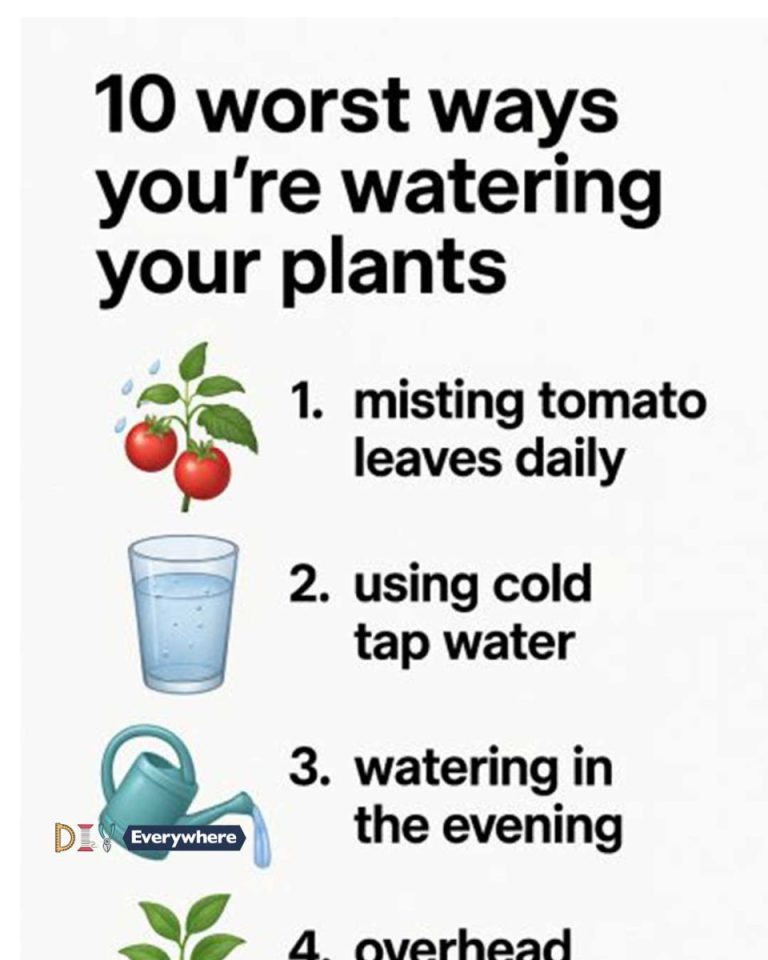10 worst ways you’re watering your plants

1. Overwatering: The Silent Plant Killer
Overwatering is one of the most common mistakes gardeners make, and it's often done with the best intentions. When you water your plants too frequently or give them more water than they need, you risk drowning their roots. This is because excess water fills the air pockets in the soil, depriving roots of the oxygen they need to survive. An overwatered plant can exhibit symptoms like yellowing leaves, wilting, and root rot.
To avoid overwatering, ensure that the top inch of soil is dry before watering again. This simple test helps you gauge whether your plant actually needs more water. Additionally, consider the specific water needs of each plant, as some species require less frequent watering than others.
2. Misting Tomato Leaves Daily: A Recipe for Disaster
While misting can be beneficial for certain plants, doing so daily to tomato leaves is a mistake. Tomatoes are sensitive to moisture on their foliage, which can promote the growth of fungal diseases like blight. The excess moisture creates an ideal environment for spores to thrive, potentially devastating your tomato crop.
Instead of misting, focus on watering at the base of the plant to keep the leaves dry. Ensure that your tomato plants have adequate airflow and space between them to further reduce the risk of disease.
3. Using Cold Tap Water: A Shock to the System
Many people don't consider the temperature of the water they use for their plants, but this can be a crucial factor in their health. Cold tap water can shock the roots of your plants, particularly for those that are tropical in origin. Such a temperature shock can stress the plant and hinder its growth.
Ideally, you should let tap water sit out until it reaches room temperature before using it on your plants. This practice also allows chlorine to dissipate, which can be beneficial for plants sensitive to this chemical.
4. Watering in the Evening: Inviting Fungus
Watering your plants in the evening might seem convenient, but it can create conditions ripe for fungal growth. Without the sun to help evaporate excess moisture, water remains on the leaves and soil surface overnight, which can promote mold and mildew.
To prevent this, water your plants early in the morning. This timing allows the sun to dry off any water on the leaves, reducing the likelihood of fungal diseases. Morning watering also provides plants with the necessary hydration they need to face the heat of the day.
5. Overhead Watering During Sun: Scorching the Leaves
Watering plants during the heat of the day, especially by overhead methods, can cause more harm than good. The droplets of water on leaves can act like tiny magnifying glasses, focusing the sun's rays and leading to leaf burn.
To avoid scorching, water your plants at the base or use drip irrigation systems. It's best to water in the early morning or late afternoon when the sun is less intense.
6. Ignoring Soil Type and Drainage
Different plants require different soil types and drainage conditions. Using the wrong soil can lead to waterlogging or insufficient moisture retention. For example, succulents need well-draining soil to prevent root rot, while ferns prefer soil that retains moisture.
Pay attention to the specific needs of your plants and choose soil mixes that cater to those requirements. Ensuring that your pots have proper drainage holes and using gravel or stones at the bottom can also help prevent excess water from accumulating.
7. Using Hard or Chlorinated Water
Hard water contains high levels of minerals like calcium and magnesium, which can build up in the soil and affect plant health. Chlorinated water can also be harmful, particularly to sensitive plants, as it can damage roots and reduce growth.
Consider using distilled or rainwater for your plants, or let tap water sit out for a day to allow chlorine to evaporate. If hard water is a concern, a water softening system or a filtration unit can help reduce mineral content.
8. Watering on a Strict Schedule: Ignoring Plant Needs
Sticking to a rigid watering schedule can lead to both overwatering and underwatering. Plant water requirements can change based on factors like weather, season, and growth stage. By not adjusting your routine, you might miss the signs that your plant needs more or less water.
Instead of following a strict schedule, learn to read the signs your plant gives you. Check the moisture level of the soil, look for any drooping leaves, and observe the overall health of the plant before deciding to water.
9. Leaving Water in Saucers: Roots Drowning
Leaving water in the saucers under your pots can lead to root rot, as the roots sit in stagnant water and can't access the oxygen they need. This is particularly a problem for indoor plants where evaporation is slower.
Always empty excess water from saucers after watering. Ensure that your pots have drainage holes and elevate them slightly to allow water to escape more easily.
10. Spraying Water on Foliage Consistently
While some plants benefit from occasional misting, consistently spraying water on foliage can lead to problems. Constant moisture on leaves can encourage fungal diseases and pest infestations, particularly indoors where air circulation might be limited.
Focus on watering the soil and roots, where the plant can absorb water more effectively. If humidity is a concern, consider using a humidifier or placing a tray of water near your plants.
11. Watering Too Frequently: Suffocating the Roots
Watering your plants too often can prevent the soil from drying out properly, leading to poor root oxygenation. This can cause symptoms similar to overwatering, such as yellowing leaves and stunted growth.